personification 英语修辞学拟人和双关
- 格式:ppt
- 大小:1.18 MB
- 文档页数:22
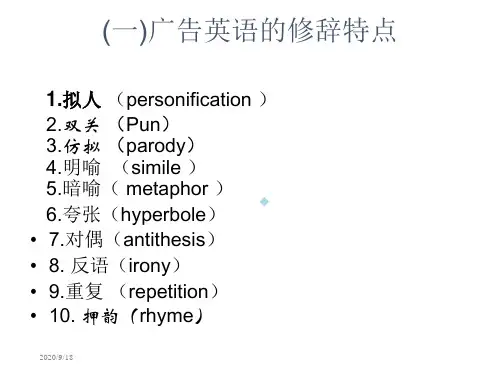


英语修辞手法总结
1. 嘿,simile(明喻)呀,就像“她的笑容像阳光一样灿烂”,这不是一下子就让你感受到她笑容的温暖了嘛!
2. 哇哦,metaphor(隐喻),比如“时间是小偷”,多形象地表达了时间悄悄偷走东西的感觉呀!
3. 嘿呀,personification(拟人),像“风在怒号”,把风当成会发怒的人,是不是很有趣呢?
4. hyperbole(夸张)可太有意思啦,“我能吃下一头牛”,这得是多大的食量呀,哈哈!
5. understatement(低调陈述),“这不算太坏”,其实可能已经挺糟糕了,但这么说就感觉还好啦。
6. irony(反讽),“你可真聪明啊”,但其实是说反话,在讽刺呢,这种感觉很奇妙吧!
7. euphemism(委婉语),“他去见上帝了”,多委婉地说一个人去世了呀。
8. metonymy(转喻),“白宫决定了”,其实是说美国政府呢,很巧妙吧!
9. synecdoche(提喻),“帆来了”其实说的是船来了,这种指代很特别呢!
10. alliteration(头韵),“Sally sells seashells by the seashore”,读起来朗朗上口,很有意思吧!
我觉得英语修辞手法真的是让语言变得丰富多彩,充满魅力呀!它们能让我们更生动、更形象地表达自己的想法和感受呢!。
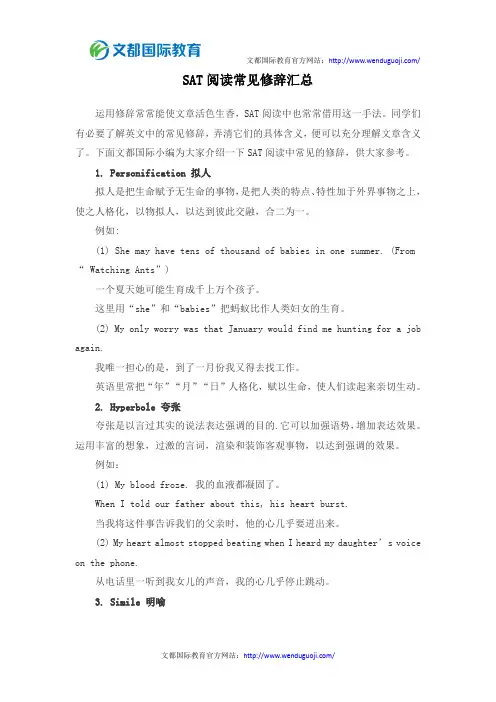
SAT阅读常见修辞汇总运用修辞常常能使文章活色生香,SAT阅读中也常常借用这一手法。
同学们有必要了解英文中的常见修辞,弄清它们的具体含义,便可以充分理解文章含义了。
下面文都国际小编为大家介绍一下SAT阅读中常见的修辞,供大家参考。
1. Personification 拟人拟人是把生命赋予无生命的事物,是把人类的特点、特性加于外界事物之上,使之人格化,以物拟人,以达到彼此交融,合二为一。
例如:(1) She may have tens of thousand of babies in one summer. (From “ Watching Ants”)一个夏天她可能生育成千上万个孩子。
这里用“she”和“babies”把蚂蚁比作人类妇女的生育。
(2) My only worry was that January would find me hunting for a job again.我唯一担心的是,到了一月份我又得去找工作。
英语里常把“年”“月”“日”人格化,赋以生命,使人们读起来亲切生动。
2. Hyperbole 夸张夸张是以言过其实的说法表达强调的目的.它可以加强语势,增加表达效果。
运用丰富的想象,过激的言词,渲染和装饰客观事物,以达到强调的效果。
例如:(1) My blood froze. 我的血液都凝固了。
When I told our father about this, his heart burst.当我将这件事告诉我们的父亲时,他的心几乎要迸出来。
(2) My heart almost stopped beating when I heard my daughter’s voice on the phone.从电话里一听到我女儿的声音,我的心几乎停止跳动。
3. Simile 明喻明喻是将具有共性的不同事物作对比,这种共性存在于人们的心里,而不是事物的自然属性。
或者说是以两种具有相同特征的事物和现象进行对比,表明本体和喻体之间的相似关系,两者都在对比中出现。
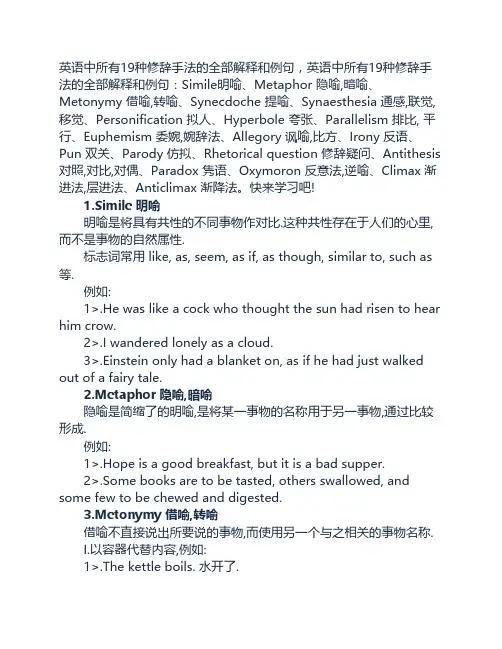
英语中所有19种修辞手法的全部解释和例句,英语中所有19种修辞手法的全部解释和例句:Simile明喻、Metaphor 隐喻,暗喻、Metonymy 借喻,转喻、Synecdoche 提喻、Synaesthesia 通感,联觉,移觉、Personification 拟人、Hyperbole 夸张、Parallelism 排比, 平行、Euphemism 委婉,婉辞法、Allegory 讽喻,比方、Irony 反语、Pun 双关、Parody 仿拟、Rhetorical question 修辞疑问、Antithesis 对照,对比,对偶、Paradox 隽语、Oxymoron 反意法,逆喻、Climax 渐进法,层进法、Anticlimax 渐降法。
快来学习吧! 1.Simile 明喻 明喻是将具有共性的不同事物作对比.这种共性存在于人们的心里,而不是事物的自然属性. 标志词常用 like, as, seem, as if, as though, similar to, such as 等. 例如: 1>.He was like a cock who thought the sun had risen to hear him crow. 2>.I wandered lonely as a cloud. 3>.Einstein only had a blanket on, as if he had just walked out of a fairy tale. 2.Metaphor 隐喻,暗喻 隐喻是简缩了的明喻,是将某一事物的名称用于另一事物,通过比较形成. 例如: 1>.Hope is a good breakfast, but it is a bad supper. 2>.Some books are to be tasted, others swallowed, and some few to be chewed and digested. 3.Metonymy 借喻,转喻 借喻不直接说出所要说的事物,而使用另一个与之相关的事物名称. I.以容器代替内容,例如: 1>.The kettle boils. 水开了. 2>.The room sat silent. 全屋人安静地坐着. II.以资料.工具代替事物的名称,例如: Lend me your ears, please. 请听我说. III.以作者代替作品,例如: a complete Shakespeare 莎士比亚全集 VI.以具体事物代替抽象概念,例如: I had the muscle, and they made money out of it. 我有力气,他们就用我的力气赚钱. 4.Synecdoche 提喻 提喻用部分代替全体,或用全体代替部分,或特殊代替一般. 例如: 1>.There are about 100 hands working in his factory.(部分代整体) 他的厂里约有100名工人. 2>.He is the Newton of this century.(特殊代一般) 他是本世纪的牛顿. 3>.The fox goes very well with your cap.(整体代部分) 这狐皮围脖与你的帽子很相配. 5.Synaesthesia 通感,联觉,移觉 这种修辞法是以视.听.触.嗅.味等感觉直接描写事物.通感就是把不同感官的感觉沟通起来,借联想引起感觉转移,“以感觉写感觉”。
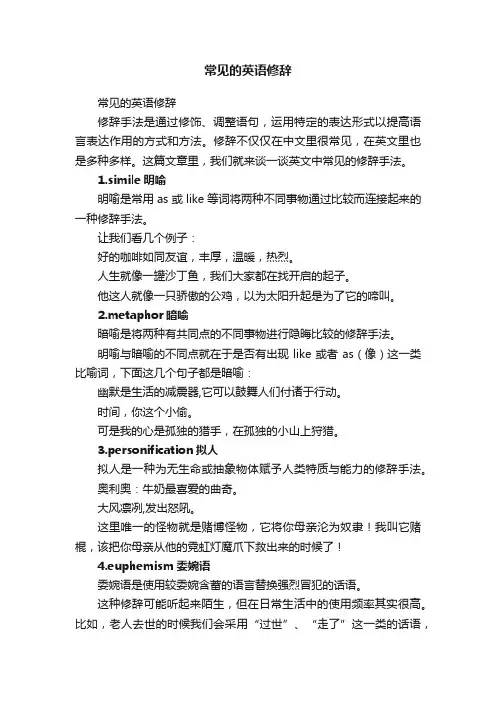
常见的英语修辞常见的英语修辞修辞手法是通过修饰、调整语句,运用特定的表达形式以提高语言表达作用的方式和方法。
修辞不仅仅在中文里很常见,在英文里也是多种多样。
这篇文章里,我们就来谈一谈英文中常见的修辞手法。
1.simile明喻明喻是常用as或like等词将两种不同事物通过比较而连接起来的一种修辞手法。
让我们看几个例子:好的咖啡如同友谊,丰厚,温暖,热烈。
人生就像一罐沙丁鱼,我们大家都在找开启的起子。
他这人就像一只骄傲的公鸡,以为太阳升起是为了它的啼叫。
2.metaphor暗喻暗喻是将两种有共同点的不同事物进行隐晦比较的修辞手法。
明喻与暗喻的不同点就在于是否有出现like或者as(像)这一类比喻词,下面这几个句子都是暗喻:幽默是生活的减震器,它可以鼓舞人们付诸于行动。
时间,你这个小偷。
可是我的心是孤独的猎手,在孤独的小山上狩猎。
3.personification拟人拟人是一种为无生命或抽象物体赋予人类特质与能力的修辞手法。
奥利奥:牛奶最喜爱的曲奇。
大风凛冽,发出怒吼。
这里唯一的怪物就是赌博怪物,它将你母亲沦为奴隶!我叫它赌棍,该把你母亲从他的霓虹灯魔爪下救出来的时候了!4.euphemism委婉语委婉语是使用较委婉含蓄的语言替换强烈冒犯的话语。
这种修辞可能听起来陌生,但在日常生活中的使用频率其实很高。
比如,老人去世的时候我们会采用“过世”、“走了”这一类的话语,这其实就是委婉语。
英文里也有类似的用法,了解委婉语背后真正的含义对阅读英语文章也是很有帮助的哦~下面我们就一起看几个例子:elder citizen老年人(不用old people)pass away逝世(不用die)You've got a prime figure.你的体态丰腴。
(不用fat)5.pun双关语双关语是指利用同词不同义或是同音不同词来制造文字游戏的一种修辞方式。
部分电视剧的幽默效果就是通过双关语来实现的。
生前劳碌奔命,死后化灰入土。
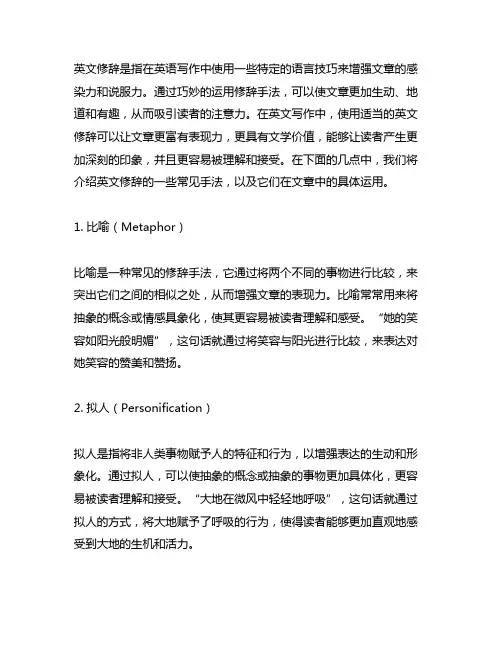
英文修辞是指在英语写作中使用一些特定的语言技巧来增强文章的感染力和说服力。
通过巧妙的运用修辞手法,可以使文章更加生动、地道和有趣,从而吸引读者的注意力。
在英文写作中,使用适当的英文修辞可以让文章更富有表现力,更具有文学价值,能够让读者产生更加深刻的印象,并且更容易被理解和接受。
在下面的几点中,我们将介绍英文修辞的一些常见手法,以及它们在文章中的具体运用。
1. 比喻(Metaphor)比喻是一种常见的修辞手法,它通过将两个不同的事物进行比较,来突出它们之间的相似之处,从而增强文章的表现力。
比喻常常用来将抽象的概念或情感具象化,使其更容易被读者理解和感受。
“她的笑容如阳光般明媚”,这句话就通过将笑容与阳光进行比较,来表达对她笑容的赞美和赞扬。
2. 拟人(Personification)拟人是指将非人类事物赋予人的特征和行为,以增强表达的生动和形象化。
通过拟人,可以使抽象的概念或抽象的事物更加具体化,更容易被读者理解和接受。
“大地在微风中轻轻地呼吸”,这句话就通过拟人的方式,将大地赋予了呼吸的行为,使得读者能够更加直观地感受到大地的生机和活力。
3. 排比(Parallelism)排比是一种修辞手法,通过重复使用相同的句式或结构,来增强文章的节奏感和说服力。
排比可以使文章更加流畅和易读,同时也能够增强文章的表现力和感染力。
“我不会畏惧困难,我不会退缩,我会勇往直前”,这句话就通过排比的方式,将相似结构的短语进行重复,来表达作者坚定的决心和信念。
4. 借代(Metonymy)借代是一种常见的修辞手法,通过用一个与被表示的对象有密切关系的词来代指该对象,以增强文章的表现力和表达的准确性。
借代可以使文章更加简练和生动,同时也能够使文章更加富有文学气息和艺术感。
“政府宣布了新政策”,这句话中的“政府”就是借代,用来代指政府发布新政策的行为。
5. 比较(Simile)比较是一种常见的修辞手法,通过使用“像”、“如同”等词语将两个不同的事物进行比较,来突出它们之间的相似之处。


英语常用修辞格分类Figures of SpeechSimile (明喻):Wrong ideas may harm man just like diseases.Her face is as white as a paper.Metaphor (暗喻):He is the soul of the team.My desk is flooded with paper.There are a few lordly poplars before the house.The charcoal fire glowed and dimmed rhythmically to the stroke of the bellows. Personification (拟人):The leaves are trembling in the cold wind.Metonymy (转喻,借代):His unfriendly tongue surprised her.The grey hair should be respect.Synecdoche (提喻,部分整体):The farms were short of hands during the harvest season.They share the same roof.England won the football.Euphemism (委婉):He unfortunately passed away last year.He is out visiting the necessary.Irony (反语):You are a fine goalkeeper, allowing the other side to score six goals. Overstatement/hyperbole (夸大的叙述):Thanks a million.She wept oceans of tears.His anger nearly burst his belly.His friends praised his daughter’s performance to the skies.She eats like a bird.Understatement (保守的陈述):“What do you think of the roast duck?” “Not bad.”He has got heart trouble, but it is nothing serious.Transferred epithet (转移修饰语):The old man put a reassuring hand on my shoulder.He crashed down on a protesting chair.Oxymoron (矛盾修饰法):She read the long-awaited letter with a tearful smile.Parting is such a sweet sorrow.Alliteration (头韵):Time and tide wait for no man.Pun (双关):They pray for you today and prey on you tomorrow.Women have a wonderful sense of right and wrong, but little sense of right and left.Customer: Waiter, will the pancakes be long? -Waiter: No, sir, round.In the window of a hearing-aid shop: “Trust us, over 5000 ears (years) of experience.”-Why can you never expect a fisherman to be so generous?-Because his business makes him sell fish (selfish).Analogy (类比):Knowledge is to the mind what nutrition is to the body.Antonomasia (换称, 专有名词代普通名词,人名、地名):He spent the whole winter in the Windy City. (Chicago)Shanghai is the New York of China.Allusion (暗示):Grammar may be his heel of Achilles.语法是他的大弱点。
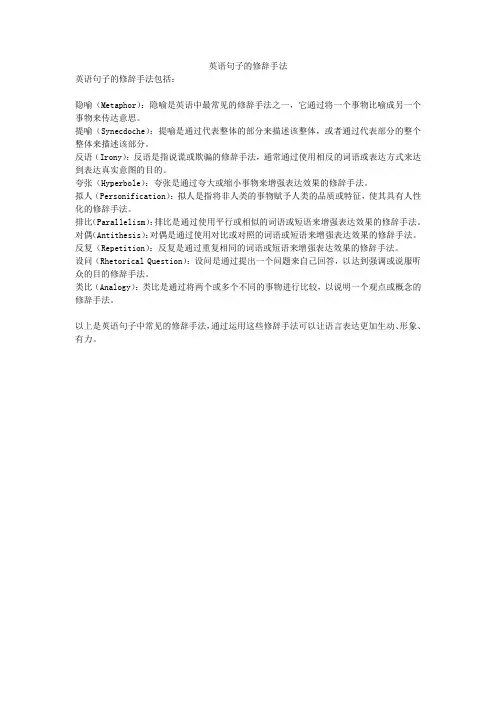
英语句子的修辞手法
英语句子的修辞手法包括:
隐喻(Metaphor):隐喻是英语中最常见的修辞手法之一,它通过将一个事物比喻成另一个事物来传达意思。
提喻(Synecdoche):提喻是通过代表整体的部分来描述该整体,或者通过代表部分的整个整体来描述该部分。
反语(Irony):反语是指说谎或欺骗的修辞手法,通常通过使用相反的词语或表达方式来达到表达真实意图的目的。
夸张(Hyperbole):夸张是通过夸大或缩小事物来增强表达效果的修辞手法。
拟人(Personification):拟人是指将非人类的事物赋予人类的品质或特征,使其具有人性化的修辞手法。
排比(Parallelism):排比是通过使用平行或相似的词语或短语来增强表达效果的修辞手法。
对偶(Antithesis):对偶是通过使用对比或对照的词语或短语来增强表达效果的修辞手法。
反复(Repetition):反复是通过重复相同的词语或短语来增强表达效果的修辞手法。
设问(Rhetorical Question):设问是通过提出一个问题来自己回答,以达到强调或说服听众的目的修辞手法。
类比(Analogy):类比是通过将两个或多个不同的事物进行比较,以说明一个观点或概念的修辞手法。
以上是英语句子中常见的修辞手法,通过运用这些修辞手法可以让语言表达更加生动、形象、有力。
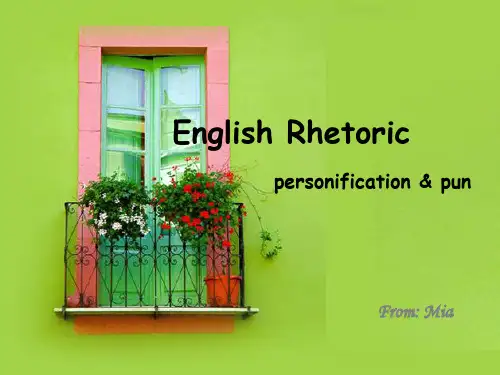
大学英语修辞手法总结4) Personification: (拟人)It gives human form of feelings to animals, or life and personal attributes(赋予) to inanimate(无生命的) objects, or to ideas and abstractions(抽象). For example, the wind whistled through the trees.5) Hyperbole: (夸张):It is the deliberate use of overstatement or exaggeration to achieve emphasis. For instance, he almost died laughing.6) Understatement: (含蓄陈述) It is the opposite of hyperbole, or overstatement. It achieves its effect of emphasizing a fact by deliberately(故意地) understating it, impressing the listener or the reader more by what is merely implied or left unsaid than by bare statement. For instance, It is no laughing matter.7) Euphemism: (委婉) It is the substitution of an agreeable or inoffensive(无冒犯) expression for one that may offend or suggest something unpleasant. For instance, we refer to "die" as” pass away".8) Metonymy (转喻) It is a figure of speech that has to do with the substitution of the mane of one thing for that of another. For instance, the pen (words) is mightier than the sword (forces).9) Synecdoche (提喻) It is involves the substitution of the part for the whole, or the whole for the part. For instance, they say there's bread and work for all. She was dressed in silks.10) Antonomasia (换喻)It has also to do with substitution. It is not often mentioned now, though it is still in frequent use. For example, Solomon for a wise man. Daniel for a wise and fair judge. Judas for a traitor.11) Pun: (双关语) It is a play on words, or rather a play on the form and meaning of words. For instance, a cannon-ball took off his legs, so he laid down his arms. (Here "arms" has two meanings: a person's body; weapons carried by a soldier.) 12) Solipsism: (一语双叙) It has two connotations. In the first case, it is a figure by which a word, or a particular form or inflection of a word, refers to two or more words in the same sentence, while properly applying to or agreeing with only on of them in grammar or syntax(句法). For example, He addressed you and me, and desired us to follow him. (Here we are used to refer to you and me.)In the second case, it a word may refer to two or more words in the same sentence. For example, while he was fighting, and losing limb and mind, and dying, others stayed behind to pursue education and career. (Here to losing one's limbs in literal; to lose one's mind is figurative, and means to go mad.)13) Zeugma: (轭式搭配) It is a single word which is made to modify or to govern two or more words in the same sentence, wither properly applying in sense to onlyone of them, or applying to them in different senses. For example, the sun shall not burn you by day or the moon by night. (Here noon is not strong enough to burn) 16) Sarcasm: (讽刺) It Sarcasm is a strong form of irony. It attacks in a taunting and bitter manner, and its aim is to disparage, ridicule and wound the feelings of the subject attacked. For example, laws are like cobwebs, which may catch small flies, but let wasps break through.17) Paradox: (似非而是的`隽语) It is a figure of speech consisting of a statement or proposition which on the face of it seems self-contradictory, absurd or contrary toestablished fact or practice, but which onfurther thinking and study may prove to be true, well-founded, and even to contain a succinct point. For example more haste, less speed.19) Antithesis: (对照) It is the deliberate arrangement of contrasting words or ideas in balanced structural forms to achieve emphasis. For example, speech is silver; silence is golden.20) Epigram: (警句) It states a simple truth pithily(有利地) and pungently(强烈地). It is usually terse and arouses interest and surprise by its deep insight into certain aspects of human behavior or feeling. For instance, Few, save the poor, feel for the poor.21) Climax: (渐进) It is derived from the Greek word for "ladder" and implies the progression of thought at a uniform or almost uniform rate of significance or intensity, like the steps of a ladder ascending evenly. For example, I came, I saw, I conquered.22) Anti-climax or bathos: (突降)It is the opposite of Climax. It involves stating one's thoughts in a descending order of significance or intensity, from strong to weak, from weighty to light or frivolous. For instance, But thousands die, without or this or that, die, and endow(赋予) a college, or a cat.23) Apostrophe: (顿呼) In this figure of speech, a thing, place, idea or person (dead or absent) is addressed as if present, listening and understanding what is being said.For instance, England! awake! awake! awake!24) Transferred Epithet: (转类形容词) It is a figure of speech where an epithet (an adjective or descriptive phrase) is transferred from the noun it should rightly modify(修饰) to another to which it does not really apply or belong. For instance, I spent sleepless nights on my project.25) Alliteration: (头韵) It has to do with the sound rather than the sense of words for effect. It is a device that repeats the same sound at frequent intervals(间隔) and since the sound repeated is usually the initial consonant sound, it is also called"front rhyme". For instance, the fair breeze blew, the white foam flew, the furrow followed free.26) Onomatopoeia: (拟声) It is a device that uses words which imitate the sounds made by an object (animate or inanimate), or which are associated with or suggestive(提示的) of some action or movement。
拟人( personification )也称为“人格化”、“静物动化”。
(1)That mistake has killed his chances. (他因那个错误已经多次丢失了机会。
) 个体名词作主语。
(2) The receipt of your letter ended my anxiety. (收到你的来信以后,我的苦恼就烟消云散了。
) 行为抽象名词作主语。
(3) The thick carpet killed the sound of his footsteps. (他走在厚厚的地毯上,一点脚步声也没有。
)(4)1949 witnessed the founding of the People’s Republic ofChina. (1949 年中华人民共和国成立。
)(5) Every day sees our motherland flourishing. (我们的祖国日益昌盛。
)(6)But this sentence hands us a completely different idea. (但这个句子向我们表达出一种完全不同的思想。
) hand 表“表达、传递”意。
(7)Despair seized us as we felt the boat sinking under us. (感到乘坐的船正在下沉,我们绝望了。
) seize 表“抓住、击跨”意。
(8)Wide reading gives wide culture. (广泛阅读会丰富文化知识。
) give 是动名词主语后的喻义动作。
(9)Her eyes spoke to him at the party. (在宴会上她对他眉目传情。
)(10)Constant dripping wears the stone. (滴水穿石。
)(11)Activity leads to happiness. (活动可以带来幸福。
)(12)Talking mends no holes. (空谈无济于事。
英语修辞简介英语修辞简介一、明喻【Simile】1、用like表示The Great Wall of China, the longest wall in the world, runs across north China like a huge dragon.Living without an aim is like sailing without a compass. 【John Ruskin】He was like a cock who thought the sun had risen for him to crow. 【George Eliot】Marriage is like a beleaguered fortress: those who are without want to getin,and those within want to get out. 【P. M. Quitard】They will never be able to save money to buy a new house---they both spendmoney like water.2、用as表示Every tree and every branch was encrusted with bright and delicate hoarfrost,white and pure, as snow, delicate and defined as carved ivory.His face was as grey as ashes.As the lion is king of beasts, so is the eagle king of birds.3、用what表示What light is to the eye, knowledge is to the mind.Reading is to the mind what exercise is to the body.Judicious praise is to the children what the sun is to flowers.4、用the way表示I should smell it the way a cat smells a mouse.5、用might (may) as well…(as)表示You might as well expect the sun to rise in the west as hope to move me.You might as well teach a cat to swim as teach him to learn English.6、用(no) more…than / not…any more than表示A home without love is no more than a body without a soul.Nations are not to be judged by their size any more than individuals.7、用of短语表示Who might he be, that black pillar of a man?Her son is shy of persons;he is a girl of a boy.8、用as if (though)表示The first time I read an excellent book, it was to me as if I had gained a new friend.9、用and表示Truth and rose have thorns about them.Love and a cough cannot be hid.二、暗喻【Metaphor】1、 S+be+RLife is a journey.Experience is the mother of wisdom.The boy is only skin and bone.2、 S+be+not+RPraise is not pudding.Knowledge is not always a water that washes away vice.3、 S---RAmerica---the Melting Pot?Proverbs in conversation---torches in darkness.4、 S+R; /,/ /and/ S+RPoliteness is required in man; scent is required in a flower.A mirror is of no use to a blind man, nor knowledge to a man without discernment.A bird is known by its note and a man by his talk.5、 No S, no RNo bees, no honey; no work, no money. No pains, no gains.6、只出现R,不出现SA silver plate is rising up in the sky.The backbone of the team is over there.7、名词1+of+名词2Poor Joe lives in that match-box of a house.He is young, broad of back, full of vigor, ---really a giant of man.8、用动词表示Waves thundered against the rocks. 水浪猛烈地拍击着岩岸。